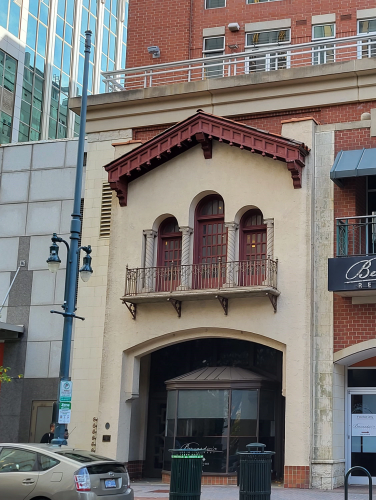
Ratcliffe Florist Shop
(ca. 1929)
Started in 1917, the Ratcliffe Florist Shop served uptown Charlotte from its William Peeps-designed Mediterranean Revival building from 1929 to 1989.
413 S. Tryon St., Charlotte, NC 28202
Louis G. Ratcliffe (1893-1961) started his floral business in 1917, next to the Latta Arcade in the 300 block of South Tryon Street. The street then was a mixture of homes, small businesses, and random vacant properties. A native of Henrico County, Virginia, Ratcliffe entered the military just one year later, serving in France during World War I, where he was awarded the Purple Heart. After the war, he returned to Charlotte to resume his business while becoming an active participant in the city's business and civic life for more than fifty years. His community service included tenures as chairman of the Mecklenburg County Democratic Party and the local Welfare Board, President of the Charlotte Chapter of the American Red Cross, a director of Home Federal Building and Loan, and a National Committeeman of the American Legion. Ratcliffe was also a Rotarian, a Mason, a Shriner, and a steward of his church.
Property Quick Links
The Ratcliffe Florist Shop building is considered one of Charlotte’s best examples of the Mediterranean Revival Style of architecture. The building is one of several commercial buildings along Tryon Street designed by William H. Peeps (1868-1950) – a twentieth-century Charlotte architect of local and regional importance – including the Latta Arcade, the Hovis Funeral Home building, and two skyscrapers (the Johnston Building and the First National Bank Building). Originally located at 431 South Tryon Street, where the decades-old Ratcliffe Florist Shop neon sign still stands, the Ratcliffe building was moved to its present location (half a block up, to 413 South Tryon) in the early 2000s so that First Union National Bank (now Wells Fargo) could build an underground parking deck.
Peeps was four years old when his family immigrated from London, England, to Grand Rapids, Michigan. Like his father, Peeps started as a furniture designer. He later apprenticed in architecture, working in part with Chicago architect Frederick W. Perkins. Peeps moved to Charlotte between 1905 and 1910 and became a leading player in the city’s development into a regional hub of business and architectural activity, including service as president of the North Carolina chapter of the American Institute of Architects. His work included several fashionable residences in and around Charlotte such as the G. G. Galloway House on East Morehead Street, his own home on East Worthington Street, the Lethco House on the Queens University campus, the E. T. Cannon House in Concord, Salisbury’s Hanford House, and the Z. V. Pate House in Laurinburg. He also designed such notable building as Gastonia’s North Carolina Orthopedic Hospital and the Masonic temples in Gastonia and Waynesville.

